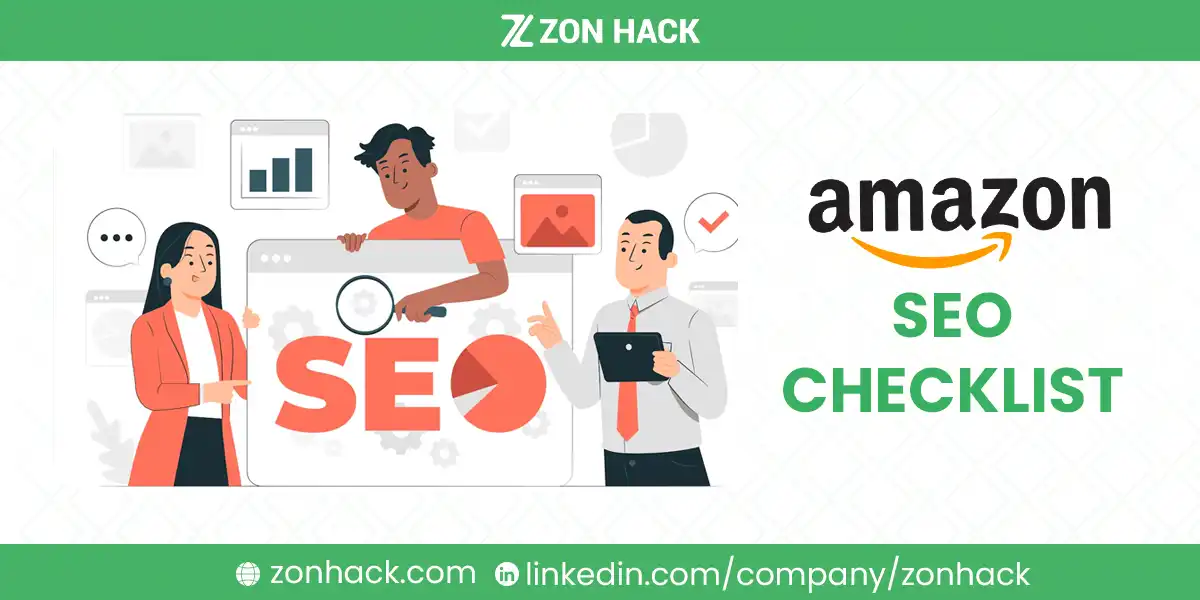Amazon’s marketplace has become increasingly sophisticated, with over 9.7 million sellers worldwide competing for visibility. Success on this platform isn’t merely about having great products—it’s about ensuring those products are discoverable by the right customers at the right time. This guide delves covers every aspect of Amazon SEO, providing sellers with actionable strategies and detailed implementations.
SEO Checklist for Amazon
Amazon’s A10 algorithm is fundamentally different from traditional search engines like Google. While Google focuses on information relevance, Amazon’s algorithm is built around one primary goal: driving sales. Understanding this core difference is crucial for sellers looking to optimize their listings effectively.
Product Title Optimization
Product titles represent the most critical element of Amazon SEO. A well-crafted title must balance keyword optimization with readability while adhering to Amazon’s guidelines. Let’s examine the anatomy of an effective product title through real-world examples.
Consider these three versions of the same product title, each demonstrating increasing levels of optimization:
Basic Title (Poor Optimization): “Wireless Bluetooth Headphones Black”
This title fails to capture essential product features and lacks the detail necessary for proper indexing.
Improved Title (Better Optimization): “TechSound Pro X300 Wireless Headphones with Noise Cancelling, 50 Hour Battery Life, Black”
This version includes key features but still misses opportunities for additional relevant keywords.
Optimal Title (Perfect Optimization): “TechSound Pro X300 Professional Wireless Headphones with Industry-Leading Active Noise Cancellation, 50-Hour Battery Life, Memory Foam Comfort, Bluetooth 5.0 for Business Travel & Home Office (Midnight Black, Over-Ear)”
This final version maximizes the available character count while maintaining readability and incorporating all crucial search terms.
Product Description Creation
The product description section offers an opportunity to expand on your product’s features while naturally incorporating additional keywords. Here’s an example of how to transform a basic description into an SEO-optimized masterpiece:
Basic Description (Poor): “These wireless headphones offer good sound quality and comfortable wear. They have noise cancellation and long battery life.”
Optimized Description (Excellent): “Experience audio excellence with the TechSound Pro X300, where professional-grade sound meets unparalleled comfort. These premium wireless headphones harness advanced active noise cancellation technology to create your personal sanctuary of silence, whether you’re navigating busy commutes or focusing in a crowded office. The industry-leading 50-hour battery life ensures your music plays on through multiple workdays, while memory foam ear cushions wrapped in premium protein leather provide lasting comfort during extended listening sessions.
Powered by the latest Bluetooth 5.0 technology, these professional-grade headphones deliver crystal-clear audio with zero latency, perfect for virtual meetings and conference calls. The built-in array of four high-sensitivity microphones ensures your voice comes through with exceptional clarity, making every business call sound like a face-to-face conversation.
The TechSound Pro X300 adapts to your lifestyle with intelligent features like automatic wear detection, which seamlessly pauses your audio when you remove the headphones and resumes when you put them back on. The intuitive touch controls on the right ear cup give you complete command over your audio experience, from adjusting volume to managing calls with simple gestures.”
Keyword Research and Implementation
Effective keyword research requires a multi-faceted approach that goes beyond basic tools. Here’s a detailed process using a real-world example:
Start with broad market analysis. For wireless headphones, examine common search patterns across different customer segments. Professional users might search for “noise cancelling headphones for zoom calls,” while commuters might look for “comfortable headphones for long flights.”
Next, analyze customer language patterns through review mining. When examining reviews for premium headphones, you might discover customers frequently mentioning phrases like “perfect for conference calls,” “great for blocking office noise,” or “comfortable during long flights.” These natural language patterns become valuable additions to your keyword strategy.
Backend Search Terms
Backend search terms require strategic implementation to maximize their impact. Here’s an example of how to properly structure backend search terms for our wireless headphones:
Poor Implementation: “wireless headphones bluetooth headphones noise cancelling headphones anc headphones”
This approach wastes characters by repeating words unnecessarily.
Optimal Implementation: “wireless bluetooth noise cancelling anc audio headset earphones professional business travel airplane flight office zoom teams meetings conference calls comfortable memory foam over ear”
Product Image Optimization
Product images must tell a complete visual story while maintaining technical excellence. For our wireless headphones example, here’s how to structure a perfect image sequence:
The main image shows the headphones against a pure white background, positioned at a three-quarter angle to display both the ear cups and headband. The product fills 85% of the frame, allowing customers to see details clearly while maintaining proper proportion.
The second image demonstrates scale, showing the headphones worn by a model in a professional setting. This helps customers understand the size and fit while reinforcing the product’s intended use case.
The third image focuses on technical specifications, using professional diagrams to highlight features like the noise-cancelling microphones, battery location, and touch control areas.
Enhanced Brand Content
For brands registered with Amazon, Enhanced Brand Content (now called A+ Content) provides additional opportunities for optimization. Here’s how to structure A+ Content effectively:
The opening module should feature a hero image of the headphones in use, accompanied by three key benefit statements: “Industry-Leading Noise Cancellation” “50-Hour Battery Life” “Professional-Grade Comfort”
Each subsequent module should expand on these benefits with detailed explanations and supporting imagery. For example, the noise cancellation section might include a technical diagram showing how the multiple microphones work together to create a quiet environment.
Performance Monitoring and Optimization
Successful Amazon SEO requires continuous monitoring and adjustment. Here’s a detailed approach to tracking and improving performance:
Monitor search term ranking positions daily, noting any significant changes. If rankings drop for key terms, examine recent changes in the market such as new competitor listings or pricing adjustments.
Track conversion rates across different traffic sources. For instance, if organic traffic converts at 15% but PPC traffic only converts at 8%, this might indicate a misalignment between ad keywords and listing content.
Importance of Proper Amazon SEO
The significance of implementing proper SEO strategies on Amazon extends far beyond basic visibility. When sellers optimize their listings correctly, they create a foundation for sustained marketplace success.
Enhanced Visibility and Traffic Generation
Proper SEO implementation directly affects a product’s visibility in search results. Higher rankings lead to increased organic traffic, which typically converts at a higher rate than paid traffic. The Amazon algorithm favors listings that demonstrate consistent performance in terms of clicks and conversions, creating a positive feedback loop for well-optimized products.
Competitive Edge in the Marketplace
In the crowded Amazon marketplace, proper SEO provides a significant competitive advantage. Optimized listings appear more frequently in relevant searches, capture more organic traffic, and generally require less reliance on paid advertising to maintain visibility. This advantage compounds over time as listings build authority within their respective categories.
Long-term Growth and Sustainability
Unlike paid advertising, which ceases to deliver results when the budget runs out, SEO provides lasting benefits. Well-optimized listings continue to perform effectively over time, creating a sustainable foundation for business growth. This includes maintaining consistent organic traffic, building brand recognition, and establishing market authority within specific categories.
Data-Driven Decision Making
The process of implementing and monitoring SEO strategies provides valuable insights into customer behavior and preferences. These insights inform future optimization efforts and help sellers understand seasonal trends, competition patterns, and evolving customer needs.
Wrapping Up
Success in Amazon SEO comes from understanding and implementing these various elements as part of a cohesive strategy. Each component works together to create listings that not only rank well in search results but convert browsers into buyers effectively.
The key to lasting success lies in continuous optimization and adaptation to changing market conditions. Sellers who approach their listings with this level of detail and commitment to excellence will find themselves well-positioned for success in Amazon’s competitive marketplace.




